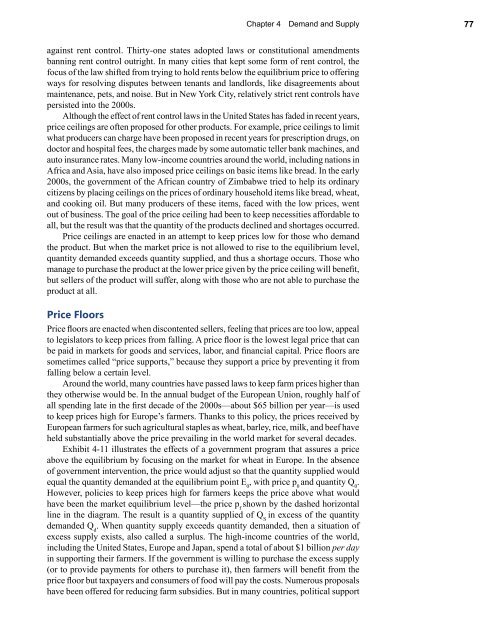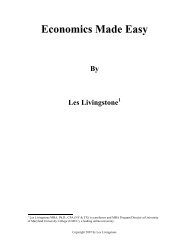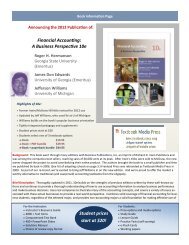Book Information / Sample Chapter(s) (PDF) - Textbook Media
Book Information / Sample Chapter(s) (PDF) - Textbook Media
Book Information / Sample Chapter(s) (PDF) - Textbook Media
Create successful ePaper yourself
Turn your PDF publications into a flip-book with our unique Google optimized e-Paper software.
<strong>Chapter</strong> 4 Demand and Supply<br />
77<br />
against rent control. Thirty-one states adopted laws or constitutional amendments<br />
banning rent control outright. In many cities that kept some form of rent control, the<br />
focus of the law shifted from trying to hold rents below the equilibrium price to offering<br />
ways for resolving disputes between tenants and landlords, like disagreements about<br />
maintenance, pets, and noise. But in New York City, relatively strict rent controls have<br />
persisted into the 2000s.<br />
Although the effect of rent control laws in the United States has faded in recent years,<br />
price ceilings are often proposed for other products. For example, price ceilings to limit<br />
what producers can charge have been proposed in recent years for prescription drugs, on<br />
doctor and hospital fees, the charges made by some automatic teller bank machines, and<br />
auto insurance rates. Many low-income countries around the world, including nations in<br />
Africa and Asia, have also imposed price ceilings on basic items like bread. In the early<br />
2000s, the government of the African country of Zimbabwe tried to help its ordinary<br />
citizens by placing ceilings on the prices of ordinary household items like bread, wheat,<br />
and cooking oil. But many producers of these items, faced with the low prices, went<br />
out of business. The goal of the price ceiling had been to keep necessities affordable to<br />
all, but the result was that the quantity of the products declined and shortages occurred.<br />
Price ceilings are enacted in an attempt to keep prices low for those who demand<br />
the product. But when the market price is not allowed to rise to the equilibrium level,<br />
quantity demanded exceeds quantity supplied, and thus a shortage occurs. Those who<br />
manage to purchase the product at the lower price given by the price ceiling will benefit,<br />
but sellers of the product will suffer, along with those who are not able to purchase the<br />
product at all.<br />
Price Floors<br />
Price floors are enacted when discontented sellers, feeling that prices are too low, appeal<br />
to legislators to keep prices from falling. A price floor is the lowest legal price that can<br />
be paid in markets for goods and services, labor, and financial capital. Price floors are<br />
sometimes called “price supports,” because they support a price by preventing it from<br />
falling below a certain level.<br />
Around the world, many countries have passed laws to keep farm prices higher than<br />
they otherwise would be. In the annual budget of the European Union, roughly half of<br />
all spending late in the first decade of the 2000s—about $65 billion per year—is used<br />
to keep prices high for Europe’s farmers. Thanks to this policy, the prices received by<br />
European farmers for such agricultural staples as wheat, barley, rice, milk, and beef have<br />
held substantially above the price prevailing in the world market for several decades.<br />
Exhibit 4-11 illustrates the effects of a government program that assures a price<br />
above the equilibrium by focusing on the market for wheat in Europe. In the absence<br />
of government intervention, the price would adjust so that the quantity supplied would<br />
equal the quantity demanded at the equilibrium point E 0<br />
, with price p 0<br />
and quantity Q 0<br />
.<br />
However, policies to keep prices high for farmers keeps the price above what would<br />
have been the market equilibrium level—the price p f<br />
shown by the dashed horizontal<br />
line in the diagram. The result is a quantity supplied of Q S<br />
in excess of the quantity<br />
demanded Q d<br />
. When quantity supply exceeds quantity demanded, then a situation of<br />
excess supply exists, also called a surplus. The high-income countries of the world,<br />
including the United States, Europe and Japan, spend a total of about $1 billion per day<br />
in supporting their farmers. If the government is willing to purchase the excess supply<br />
(or to provide payments for others to purchase it), then farmers will benefit from the<br />
price floor but taxpayers and consumers of food will pay the costs. Numerous proposals<br />
have been offered for reducing farm subsidies. But in many countries, political support













